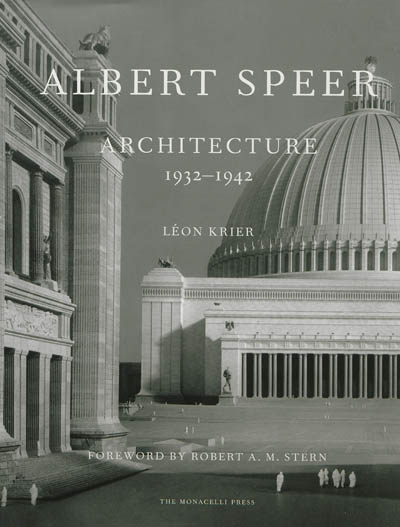par Krier, Léon (1946-....)
Monacelli Press
-
-
Disponible - 70"19" SPEE 2
Niveau 3 - Arts
par Krier, Léon (1946-....)
Monacelli Press
-
Disponible - 70"19" SPEE 2
Niveau 3 - Arts

Fac-similé de l'édition originale de cette étude consacrée à l'architecte d'Hitler complété d'une nouvelle préface de l'auteur et d'un avant-propos de R.A.M. Stern. Fondée sur des entretiens avec Speer et centrée sur son plan d'urbanisme pour Berlin ainsi que sur ses réalisations majeures, elle éclaire les liens entre son oeuvre et son projet politique tout en contribuant à l'étude du classicisme.

First published in 1985, Albert Speer Architecture 1932-1942 is a lucid, wide-ranging study of an important classical architect of the twentieth century. Yet it is simultaneously much more : a philosophical reflection on Modernity and politics on art, good and evil.
This volume presents a facsimile of the original 1985 book, complemented by a new preface by author Léon Krier and an foreword by Robert A. M. Stern.
Krier raises the fundamental question « Can a war criminal be a great artist ? » Here Krier demonstrates that Albert Speer, Adolph Hitler's architect of choice, was responsible for one of the boldest architectural and urban programs of the twentieth century. Basing his study on a series of interviews with Speer, Krier focuses on the architect's plan for Berlin, an unprecedented modernization of the city intended to be the capital of Europe. In addition to the urban plan, Speer designed buildings for major institutions, including the monumental Great Hall, Hitler's Palace, the High Command of the Armed Forces, the New Chancellery, and the Triumphal Arch. Illustrations are drawn primarily from Speer's personal archive.
Krier candidly confronts the great difficulty of disentangling the architecture and urbanism of Albert Speer from its political intentions. This difficulty notwithstanding, Krier's presentation is an important contribution to the study of classicism in architecture and architecture in the affairs of state.
Disponible - 70"19" SPEE 2
Niveau 3 - Arts